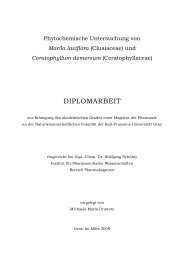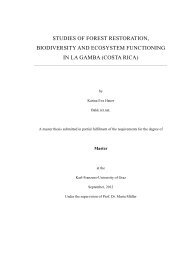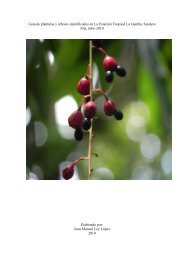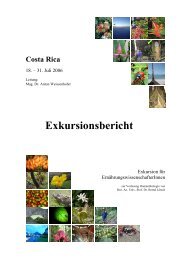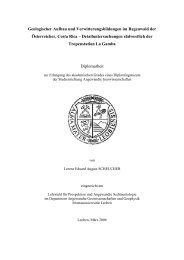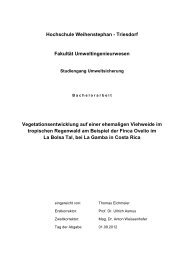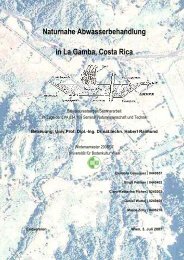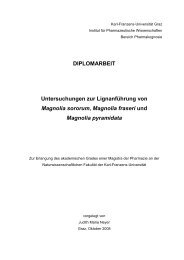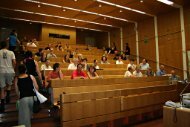Leaf colour patterns, vegetative and sexual reproduction of Episcia ...
Leaf colour patterns, vegetative and sexual reproduction of Episcia ...
Leaf colour patterns, vegetative and sexual reproduction of Episcia ...
Create successful ePaper yourself
Turn your PDF publications into a flip-book with our unique Google optimized e-Paper software.
espectively. Any explicit conclusion cannot be drawn. These statements rather point towards<br />
melittophilous syndrome though.<br />
Fruit Development<br />
Fruits are flowers in the state <strong>of</strong> seed maturity (Leins 2000). In gesneriads two different fruit<br />
types occur: dehiscent <strong>and</strong> indehiscent fruits, whereby the dehiscent dry capsular fruit represents<br />
the more primitive type (Weber 2004). The range <strong>of</strong> dispersal is from autochory, anemochory<br />
over ombrohydrochory to zoochory. Skog (1978) describes the fruit <strong>of</strong> <strong>Episcia</strong> lilacina as fleshy<br />
capsule. Residual are questions about the fruit development <strong>and</strong> the kind <strong>of</strong> distribution.<br />
Results: After a successful pollination fruit development starts in the course <strong>of</strong> just a few<br />
days. The carpels form a greenish to reddish <strong>colour</strong>ed, globular, pilose capsule that is surrounded<br />
by the persistent calyx (Fig. 28). The caspule is bivalved <strong>and</strong> fleshy.<br />
Such capsules are green when part <strong>of</strong> green plants without red leaf <strong>patterns</strong>. The fruit <strong>of</strong> all<br />
<strong>colour</strong> morphs is reddish <strong>and</strong> no opening lines are visible. The calyx grows neither in length nor<br />
does it change its <strong>colour</strong>. The inside <strong>of</strong> the capsule is dark brown to dark red. Seeds are globular,<br />
shiny, mostly reddish, rarely white.<br />
Two days after the withering <strong>of</strong> the flower it can be unmistakeably seen whether a fruit has<br />
developed or not. At this point the young fruit is covered completely by the calyx. At the<br />
beginning the fruit broadens a little bit faster than it grows in length. After approximately two<br />
weeks it is 5 mm (±2,5 mm) in diameter <strong>and</strong> has reached a length <strong>of</strong> 6 mm (±3mm). At this point<br />
the length starts to increase while the diameter <strong>of</strong> the fruit further on just slowly widens. After<br />
ten more days the diameter is 8 mm (±3mm) <strong>and</strong> its length 7 mm (±1mm). In summary, it can be<br />
said that in the course <strong>of</strong> 25 days <strong>of</strong> observation the fruit grows with an average <strong>of</strong> 5,5 mm in<br />
width as well as 4 mm in length.<br />
While the fruit development was not finished yet, it could not be observed until the end<br />
because the stay in Costa Rica came to an end at this point. Thus neither dehiscence nor the way<br />
the seeds spread could be examined.<br />
Discussion: The ripening <strong>of</strong> a fruit can take a couple <strong>of</strong> weeks or even months. Fruits <strong>of</strong><br />
Cyrt<strong>and</strong>ra gr<strong>and</strong>iflora (Gesneriaceae) for e.g. need approximately five month to ripe (Reol<strong>of</strong>s 1979).<br />
Fruit development <strong>of</strong> <strong>Episcia</strong> lilacina could only be observed for around four weeks. Presumably,<br />
it would have taken a few weeks more for the fruit to actually become ripe. Wiehler (1983)<br />
61



